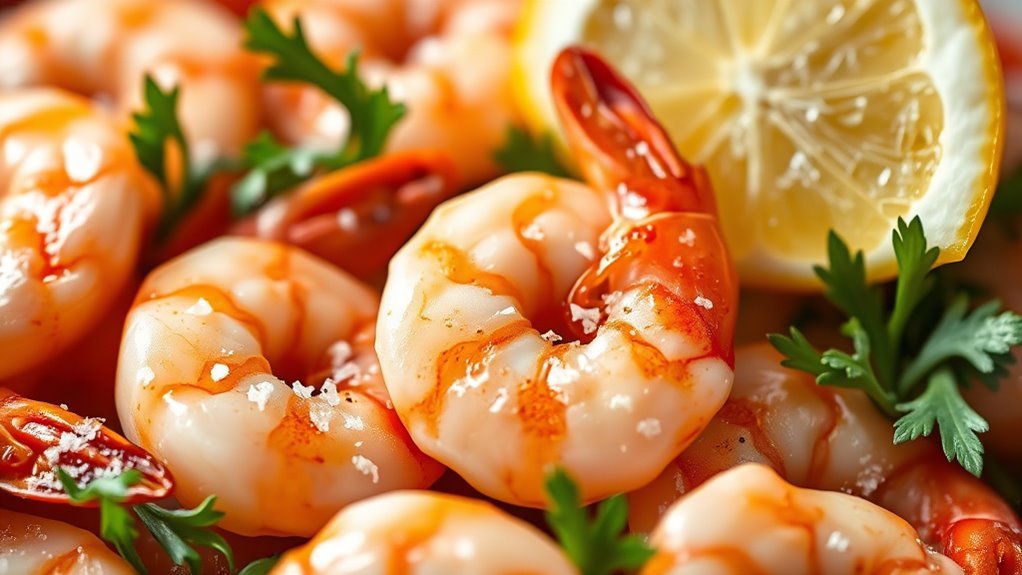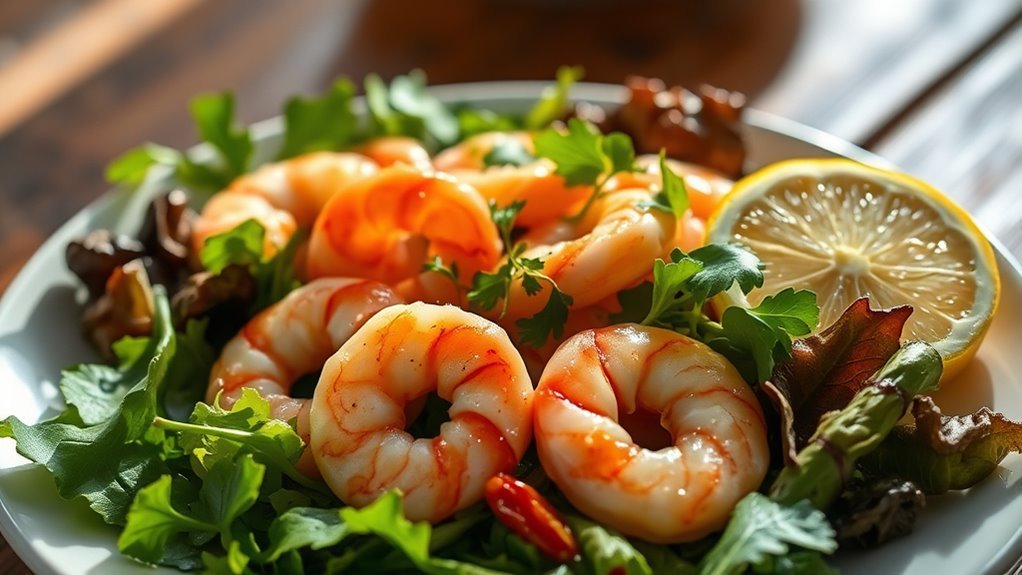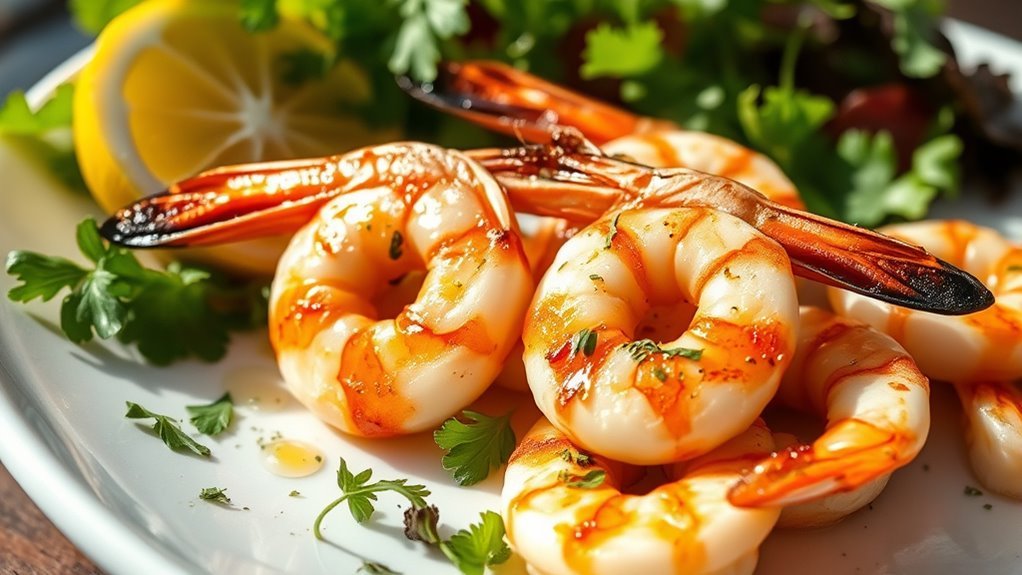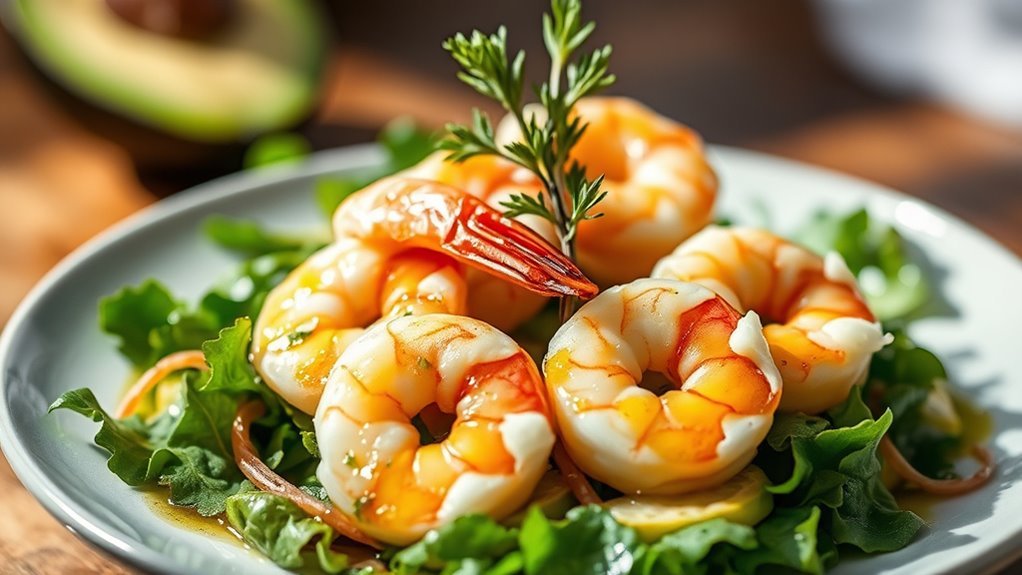Yes, shrimp is definitely keto-friendly! It’s low in carbohydrates, containing just 0.2 to 1 gram per 100 grams, making it perfect for your diet. With about 24 grams of high-quality protein per serving, it supports muscle maintenance while keeping calories low. Plus, shrimp pairs well with healthy fats like olive oil and avocado, enhancing your meals. If you want to know more about shrimp’s benefits and recipes, just keep going!
Nutritional Profile of Shrimp

When it comes to the nutritional profile of shrimp, you’ll find that this seafood is packed with beneficial components. Shrimp varieties, such as wild-caught or farmed, offer a low-calorie, high-protein option, making them an excellent choice for those seeking a healthy diet. A typical serving contains essential nutrients, including vitamin B12, iodine, and selenium, which support various bodily functions. Additionally, shrimp are low in saturated fat and carbohydrates, aligning well with keto-friendly guidelines. However, it’s vital to evaluate shrimp sustainability; opting for responsibly sourced varieties guarantees you’re making environmentally conscious choices. By choosing sustainable shrimp, you not only nourish your body but also support ocean health, promoting a balanced ecosystem for future generations. Enjoy shrimp guilt-free! Furthermore, shrimp’s low carbohydrate content makes it a suitable option for the keto diet, allowing you to enjoy its delicious flavors while maintaining ketosis.
Carbohydrate Content in Shrimp

Shrimp contains a remarkably low carbohydrate content, typically ranging from 0.2 to 1 gram of carbs per 100 grams. This makes it an excellent choice for those following a keto diet. Unlike many carbohydrate sources, shrimp varieties provide minimal carbs, allowing you to enjoy them without compromising your dietary goals.
Shrimp is an ideal low-carb option for keto diets, offering just 0.2 to 1 gram of carbs per 100 grams.
Here are some key points about the carbohydrate content in shrimp:
- Low Carb: Most shrimp varieties have negligible carbs.
- Versatile: They can be used in various dishes without adding significant carbs.
- Healthy Option: Low-carb content complements high-protein meals.
- Sustainable: Opting for shrimp is eco-friendly and nutrient-rich. Additionally, shrimp is rich in omega-3 fatty acids, which are beneficial for heart health and align well with keto dietary principles.
Protein Benefits of Shrimp

Although you may be focused on keeping your carb intake low while on a keto diet, the protein benefits of shrimp are equally significant. Shrimp is an excellent source of high-quality protein, providing about 24 grams per 3-ounce serving. This protein is essential for muscle maintenance and overall health, especially when you’re minimizing carbs. Furthermore, understanding shrimp sourcing and prioritizing shrimp sustainability can enhance your dietary choices. Opting for sustainably sourced shrimp not only supports marine ecosystems but also guarantees you’re getting a clean, nutritious product. By incorporating shrimp into your meals, you not only enjoy a delicious dish but also boost your protein intake while adhering to keto principles. Additionally, shrimp is low in carbohydrates, making it an ideal choice for those following a ketogenic lifestyle. Embrace the freedom to savor this nutrient-rich seafood!
Shrimp and Healthy Fats
Incorporating shrimp into your keto diet not only enhances your protein intake but also complements healthy fat consumption. When you think about shrimp pairing, consider these healthy fats to elevate your meals:
- Avocado – Packed with monounsaturated fats, it adds creaminess and boosts heart health.
- Olive Oil – A staple source of healthy fats, it’s perfect for sautéing shrimp or drizzling over dishes.
- Coconut Oil – Provides medium-chain triglycerides (MCTs) that can enhance ketone production.
- Nuts and Seeds – Almonds or chia seeds can add crunch and extra nutrients to your shrimp dishes. Additionally, combining shrimp with low-carb vegetables can create a well-rounded meal that supports your keto goals.
How Shrimp Fits Into a Keto Diet
When you’re looking to maintain a keto diet, shrimp can be a fantastic option due to its low carbohydrate content and high protein levels. Most shrimp varieties contain less than one gram of carbs per serving, making them ideal for your keto meal plan. Plus, shrimp is rich in essential nutrients like selenium and vitamin B12, supporting overall health. Choosing sustainably sourced shrimp not only benefits your diet but also promotes environmental responsibility. By opting for shrimp from responsible fisheries, you guarantee that you’re making a choice that supports marine ecosystems. Incorporating shrimp into your meals allows for diverse, flavorful dishes while keeping you on track with your keto goals. Additionally, shrimp’s minimal carb content helps you stay within the recommended carb intake for effective weight loss on keto. So, enjoy shrimp guilt-free as part of your healthy lifestyle!
Cooking Methods for Keto-Friendly Shrimp
When it comes to cooking shrimp on a keto diet, several methods can enhance flavor while keeping your meals low in carbs. Grilling adds a smoky richness, sautéing in butter brings out a delicious creaminess, and baking with herbs infuses your dish with aromatic goodness. Each technique not only preserves the shrimp’s natural benefits but also keeps your meals exciting and satisfying. Additionally, pairing shrimp with low-carb alternatives can further enrich your diet while maintaining keto guidelines.
Grilling for Flavor
Grilling shrimp not only enhances its natural sweetness but also adds a delicious smoky flavor that complements a keto diet perfectly. To maximize your grilling experience, consider these marinade options and grilling techniques:
- Olive Oil and Garlic: A simple mix that keeps shrimp moist while adding rich flavor.
- Citrus Marinade: Combine lemon or lime juice with herbs for a revitalizing twist.
- Spicy Marinade: Use chili powder or hot sauce for a kick that pairs well with shrimp’s sweetness.
- Herb-Infused Marinade: Fresh herbs like cilantro or parsley can elevate the dish without adding carbs.
Additionally, shrimp are low in carbs and high in protein, making them an excellent choice for a keto diet. Using these techniques, you can create mouthwatering shrimp dishes that fit seamlessly into your keto lifestyle. Enjoy the freedom of flavor without straying from your goals!
Sautéing in Butter
After enjoying the smoky flavors of grilled shrimp, you might want to explore another delicious cooking method: sautéing in butter. This technique not only enhances the shrimp’s natural sweetness but also aligns perfectly with a keto-friendly diet. When sautéing, use medium heat to preserve the shrimp’s texture and prevent overcooking.
If you’re looking for butter alternatives, consider using ghee or olive oil, which can add unique flavors while keeping the dish low in carbs. You can also incorporate garlic or lemon juice for an extra kick. Mastering these sautéing techniques allows you to create quick, flavorful meals that satisfy your cravings while sticking to your keto goals. Embrace the versatility of shrimp and enjoy a guilt-free indulgence!
Baking With Herbs
Baking shrimp with herbs not only infuses the seafood with vibrant flavors but also keeps it low in carbs, making it an excellent choice for your keto diet. By using various herb blends, you can create unique flavor profiles that elevate your dish. Here are four simple steps to bake shrimp with herbs:
- Choose Your Herbs: Opt for fresh or dried herbs like parsley, thyme, rosemary, or dill.
- Mix the Blend: Combine your selected herbs with olive oil, garlic, and lemon juice for added zest.
- Prepare the Shrimp: Toss the shrimp in the herb mixture, ensuring an even coating.
- Bake: Place on a baking sheet and cook at 400°F for about 8-10 minutes until perfectly tender.
Additionally, incorporating healthy fats like olive oil is essential for maintaining a balanced nutrient profile while on a keto diet. Enjoy your flavorful, keto-friendly shrimp!
Shrimp Recipes for Keto Enthusiasts
What could be better than a quick, delicious shrimp dish that fits perfectly into your keto lifestyle? Shrimp tacos can be a fun, low-carb twist when served in lettuce wraps. For a savory option, try garlic shrimp sautéed in olive oil. If you’re craving something fresh, whip up a shrimp salad with avocado. Want bold flavors? A shrimp curry or shrimp stir fry will satisfy those cravings while keeping your carbs in check. Don’t forget shrimp skewers on the grill for a perfect summer meal! For an Italian flair, shrimp scampi is a classic favorite. Looking for something unique? Try shrimp ceviche or crispy coconut shrimp. And if you’re feeling indulgent, there’s always shrimp pasta made with zucchini noodles. Additionally, shrimp is an excellent choice for keto dieters due to its low carb content, making it a versatile protein source.
Potential Health Benefits of Eating Shrimp
Eating shrimp can offer notable health benefits, especially for those following a keto diet. It’s packed with high-quality protein while remaining low in calories, making it an excellent choice for maintaining muscle and managing weight. Plus, shrimp are a good source of omega-3 fatty acids, which can support heart health and reduce inflammation. Regular consumption of shrimp can contribute to a healthier lifestyle, enhancing dietary freedom while providing powerful nutrients.
High Protein Content
Shrimp is a powerhouse of protein, making it an excellent choice for those following a ketogenic diet. Packed with essential amino acids, it supports muscle growth and repair while keeping you satiated. Here are some benefits of incorporating shrimp into your meals:
- High Protein Content: Shrimp boasts about 20 grams of protein per 3-ounce serving.
- Variety of Shrimp Varieties: From wild-caught to farmed, you can choose according to your taste and budget.
- Easy to Cook: Shrimp cooks quickly, making it perfect for busy weeknights.
- Versatile Ingredient: Use shrimp in salads, stir-fries, or skewers for diverse meals.
With these cooking tips, you can enjoy shrimp while benefiting from its high protein content on your keto journey!
Low in Calories
One of the appealing aspects of shrimp is its low calorie count, making it an ideal protein source for those on a ketogenic diet. With shrimp, you can enjoy a satisfying meal without overloading on calories. It’s crucial to take into account shrimp sourcing and sustainability to guarantee you’re making healthy choices that benefit both your body and the environment.
| Nutrient | Amount per 100g | % Daily Value |
|---|---|---|
| Calories | 85 | 4% |
| Protein | 20g | 40% |
| Fat | 1g | 2% |
Omega-3 Fatty Acids
While you might think of shrimp primarily for its protein content, it also offers a notable source of omega-3 fatty acids, which are essential for overall health. These healthy fats can support your well-being in several ways:
- Heart Health: Omega-3s can reduce triglycerides and lower blood pressure.
- Brain Function: They’re linked to improved cognitive function and may help protect against dementia.
- Inflammation Reduction: Omega-3s can help lower inflammation in the body.
- Sustainable Choice: Opt for shrimp sourced responsibly to guarantee environmental sustainability.
Including shrimp as one of your omega-3 sources not only enhances your diet but also aligns with sustainable eating practices. Enjoying shrimp provides both health benefits and peace of mind for your choices.
Common Concerns About Shrimp Consumption
Although shrimp is often celebrated for its low-carb content and high protein, several common concerns about its consumption warrant attention. Individuals with shrimp allergies need to be cautious, as allergic reactions can be severe. Additionally, sustainability concerns arise from shrimp farming practices, which can lead to significant environmental impact, including habitat destruction and water pollution. It’s also important to take into account mercury levels in shrimp, as these can vary depending on their source, potentially posing risks to health. Shellfish toxicity is another factor, as some regions may have contaminated waters. Finally, if you have specific dietary restrictions, it’s vital to confirm that shrimp fits within your overall nutritional goals, especially when steering through seafood choices.
Tips for Buying and Preparing Shrimp
When buying shrimp, you’ll want to contemplate whether to choose fresh or frozen options, as both have their advantages. Fresh shrimp can offer superior flavor, while frozen shrimp are often more convenient and can retain quality when properly stored. Experimenting with various cooking techniques, like grilling or sautéing, can also enhance the taste and texture of your shrimp dishes.
Fresh vs. Frozen Shrimp
Whether you’re at the seafood counter or browsing the frozen aisle, knowing how to choose shrimp can make a significant difference in your culinary experience. Here are some tips for selecting fresh or frozen shrimp:
- Freshness: Look for fresh shrimp that smell like the ocean, not fishy. Their shells should be shiny and firm.
- Frozen Quality: Opt for frozen shrimp that are individually quick-frozen (IQF) to maintain texture and flavor.
- Packaging: Check for proper packaging; avoid any that’s damaged or has ice crystals, indicating freezer burn.
- Sustainability: Research sources to verify you’re buying responsibly harvested shrimp, whether fresh or frozen.
Cooking Techniques to Try
While shrimp can be a versatile and delicious addition to your meals, knowing the best cooking techniques can elevate your dish considerably. Here are some methods to contemplate:
| Cooking Technique | Description | Tips |
|---|---|---|
| Boiling Shrimp | Quick and easy method | Add spices to the water |
| Grilling Shrimp | Adds a smoky flavor | Marinate shrimp for 30 mins |
| Sautéing Shrimp | Quick cooking on high heat | Use garlic and butter |
| Baking Shrimp | Healthy and hands-off | Top with herbs and lemon |
Don’t forget to experiment with marinating shrimp before cooking. A simple mix of olive oil, lemon juice, and your favorite spices can enhance flavor and tenderness. Enjoy the freedom to explore!
Frequently Asked Questions
Is Shrimp Safe for Those With Shellfish Allergies?
If you have a shellfish allergy, shrimp isn’t safe for you. Consuming shrimp may trigger shellfish allergy symptoms like hives, swelling, or even anaphylaxis. If you’re looking for shrimp allergy alternatives, consider fish or plant-based proteins, which can provide similar textures and flavors in your meals. Always consult with a healthcare professional before trying new foods, especially if you have known allergies. Prioritizing your health and safety is essential.
Can Shrimp Be Consumed Raw on a Keto Diet?
Yes, you can consume raw shrimp on a keto diet, but it’s crucial to verify they’re fresh and sourced from a reputable supplier. For instance, imagine enjoying a revitalizing shrimp ceviche, which showcases raw shrimp benefits like retaining more nutrients. Pair it with avocado for a delicious keto meal idea. Just make certain to practice safe food handling to avoid any health risks associated with raw seafood. Enjoy the freedom of diverse flavors while staying on track!
How Often Should I Eat Shrimp on Keto?
You can enjoy shrimp a few times a week on a keto diet, ideally in moderate portions. Aim for around 4-6 ounces per serving, depending on your overall protein needs. There are plenty of delicious shrimp recipes to try, from garlic butter shrimp to shrimp stir-fries. Just remember to balance your meals with other keto-friendly foods, ensuring you maintain a well-rounded diet while savoring those tasty shrimp dishes.
Does Shrimp Contain Any Sugar?
Shrimp doesn’t contain any sugar, making it a great option for low-carb diets. In fact, a 3-ounce serving of shrimp has about 20 grams of protein and only 1 gram of carbs! When you prepare shrimp, you can keep it healthy by grilling or steaming instead of frying. Embracing shrimp nutrition not only offers delicious meals but also allows you the freedom to enjoy flavorful dishes without the worry of hidden sugars.
Are Wild-Caught Shrimp Healthier Than Farmed Shrimp?
Yes, wild-caught shrimp are generally considered healthier than farmed shrimp. They often have fewer sustainability concerns, as overfishing practices are better regulated compared to some farming operations. Nutritionally, wild shrimp tend to be lower in fat and higher in omega-3 fatty acids. Farmed shrimp can also contain antibiotics and additives, which may affect your health. Choosing wild-caught options can offer you a more natural and environmentally friendly choice for your diet.


